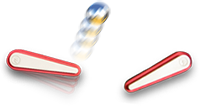I made some solid progress this past week...along with a couple mishaps.
I have reinstalled the playfield posts using #6 machine screws drilled through the playfield and nylon lock nuts. Any of the posts that were intended to support playfield plastic mounting, spinner mount, etc. I put the machine screw in from the backside. That way, the extra thread sticks out past the lock nut and I can mount things to it. Many of the post holes were stripped or very close to it, so I had to do something.
I did a lot of soldering and rewiring. I converted all autofire devices to direct logic switches rather than power switches. I installed some arcade buttons for both flipper and start buttons. There were a number of switches that had broken in half, but I go enough pieces together to finish everything.
I wanted to do a quick test with my controller board and MPF before I had everything back together. I hooked it up, flipped the power switch, and POOF...all the magic smoke was wisping up to my face. Oops. Somehow I burned out one of the PSOC boards. These are cheap, but are also discontinued and hard to find. After some sleuthing, I found that the original game had a switch matrix switch on the same switch stack as the end of stroke switch, which had 24V on it. This would not have been a big deal if I had a flipper installed. With no flipper, the flipper pawl, was pulled but its spring and shorted the two switches out. In case anyone was wondering, no, the PSOC cannot handle 24V. You can see the black pock of failure on the main IC in the image below.
I programmed another board, installed drop targets, cut out that pesky switch that shorted everything, and installed some flippers. I was a little more cautious this time during power up. I was able to run a "game" in MPF through the actual hardware. All the switches checked out and I got all solenoids firing.
For all the testing I had been bypassing a power switch on my controller. I decided to test the power switch separately. It always seemed to be on, no matter what I did. Back to the schematic. Some of you might see my mistake in the image below. I put the transistor in backward! Pins 2 and 3 should be swapped. As it stands, current can always flow through the body diode of the transistor. I do not need this capability right now so I am planning on shorting this transistor. I might dead bug a part on there for the sake of testing at some point.
This next week I hope to get this mostly reassembled and actually get a ball bouncing around to score some points!
 IMG_20191018_215935205 (resized).jpg
IMG_20191018_215935205 (resized).jpg IMG_20191020_165328732 (resized).jpg
IMG_20191020_165328732 (resized).jpg IMG_20191020_165428195 (resized).jpg
IMG_20191020_165428195 (resized).jpg Capture (resized).PNG
Capture (resized).PNG
Tag-Team Pinball playfield. It was mostly populated although a few things had been scavenged. This will be my test bed for learning to make a new game. Here is the plan:
GoldenStatePin


 West Sacramento, CA
West Sacramento, CA
 Winnipeg, MB
Winnipeg, MB

